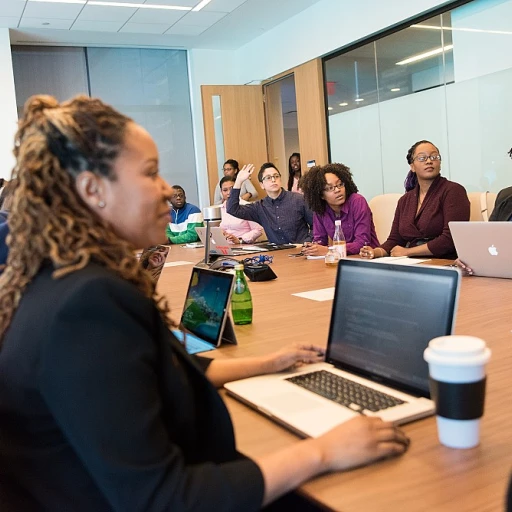
Understanding the Role of a Chief Human Resources Officer
Defining the CHRO's Role
When considering a career as a Chief Human Resources Officer (CHRO), it's essential to understand the multifaceted nature of this leadership position. A CHRO is more than just a manager of payroll, recruitment, and benefits. They encompass the strategic oversight of an organization's human capital and are pivotal in guiding organizational change and implementing change management methodologies like Prosci.
Integral to Business Strategy
CHROs operate at the intersection of human resources and business strategy, ensuring that the personnel align with the company’s overarching objectives. As businesses face rapid disruptions, the CHROs' role in managing change becomes critical. Through a deep understanding of change management processes, including frameworks like Prosci and the ADKAR model, they help navigate complex transformation initiatives.
Agents of Organizational Change
One of the CHRO's key responsibilities includes serving as an agent of change within the organization. The art of managing change effectively demands a proactive approach in recognizing the need for change, planning the change process, and leading the organization through the various phases of transformation. Using methodologies like the Prosci ADKAR model offers a structured way to drive successful change initiatives.
Challenges in Change Management
The transition into a CHRO position can present numerous challenges, particularly in change management. Balancing the strategic imperatives with the operational demands of the HR department requires expertise, authority, and a mastery of change management strategies. Staying abreast of methodologies like Prosci ensures that CHROs can effectively foster the desired transformation within their organizations.
Explore how aspiring CHROs can enhance their leadership capabilities in navigating transformational challenges here.
The Importance of Change Management in HR Leadership
The Crucial Role of Change Management in HR Leadership
The role of a Chief Human Resources Officer (CHRO) extends beyond traditional HR functions towards strategic influence within an organization. As business landscapes continue to evolve rapidly, the ability to manage organizational change efficiently becomes increasingly paramount for HR leaders. With change initiatives becoming frequent and complex, CHROs play a vital part in steering the organization through these transitions effectively. Managing change is about creating a structured approach that enables smoother implementations and minimizes disruptions. The adoption of change management methodologies, such as the Prosci model, is invaluable. This model provides a systematic framework to manage the people side of change, ensuring that any transition aligns with the organization's goals.Implementing Effective Change Management
Successful change management leverages methodologies like Prosci's ADKAR model, emphasizing Awareness, Desire, Knowledge, Ability, and Reinforcement. This systematic approach aids in understanding how individuals in the organization can transition through change, ensuring that the desired outcomes are met. Proper training and the right skill set are critical to implementing these phases successfully. As CHROs champion change, they need to develop a keen understanding of the entire change management process. Obtaining certifications, such as Prosci certification, equips HR leaders with the necessary skills and credentials to manage change effectively. Additionally, they need to work closely with various departments to integrate change management plans into the broader business objectives. By prioritizing a comprehensive change management plan, organizations can not only adapt more swiftly to changes but also bolster their competitive edge. HR leaders who master these processes contribute significantly to the organizational change objectives. For those interested in deepening their understanding of change management within HR, further insights can be explored on the understanding the role of change management in human resources blog.An Overview of the Prosci Change Management Methodology
Delving into the Prosci Change Management Framework
The Prosci change management methodology stands out as a structured and widely-recognized approach for navigating organizational change. At its core, the Prosci model is designed to facilitate successful change by emphasizing the intersection of processes and people. Understanding this framework is crucial for aspiring Chief Human Resources Officers seeking to excel in organizational change initiatives. One of the primary components of the Prosci methodology is the ADKAR model, which is instrumental in reinforcing change at an individual level. ADKAR represents Awareness, Desire, Knowledge, Ability, and Reinforcement—each a critical phase within the change management process.- Awareness: Building awareness about the need for change, ensuring that all organizational members understand the reasons behind it.
- Desire: Cultivating a genuine desire among employees to support and participate in the change process.
- Knowledge: Offering training and development to equip employees with the necessary skills and information for implementation.
- Ability: Encouraging the application of acquired skills and fostering competence in new methods or procedures.
- Reinforcement: Ensuring lasting change by integrating new practices through recognition and rewards.
Implementing Prosci in HR Strategies
Integrating Prosci into HR Strategies
Implementing the Prosci methodology in HR strategies is a crucial step for Chief Human Resources Officers aiming to drive successful organizational change. This approach provides a structured framework that can help in managing change initiatives effectively. By integrating the Prosci model, CHROs can align their HR strategies with the broader business goals, ensuring that change is not only implemented but also sustained over time.
One of the key elements of the Prosci methodology is the ADKAR model, which focuses on the individual as the unit of change. This model helps CHROs understand how to manage change at a personal level, which is essential for achieving organizational change. The ADKAR model comprises five building blocks: Awareness, Desire, Knowledge, Ability, and Reinforcement. Each phase of this model plays a critical role in ensuring that employees are not only prepared for change but also capable of adapting to new processes and systems.
Aligning Change Management with Business Objectives
To effectively implement Prosci in HR strategies, CHROs need to ensure that their change management plans are aligned with the organization's business objectives. This involves a comprehensive understanding of the business landscape and the specific challenges that the organization faces. By doing so, HR leaders can develop a change management plan that supports the organization's strategic goals, ensuring that change initiatives are not only successful but also contribute to the overall growth and development of the business.
Training and certification in the Prosci methodology can be invaluable for HR professionals seeking to enhance their change management skills. Prosci certification provides a deep understanding of the change management process, equipping HR leaders with the tools and techniques needed to manage change effectively. This training can also help in building a culture of change within the organization, where employees are more open to embracing new ideas and approaches.
Building a Supportive Change Management Framework
Creating a supportive framework for managing change is another essential aspect of implementing Prosci in HR strategies. This involves developing a management model that facilitates communication, collaboration, and engagement across all levels of the organization. By fostering an environment where people feel supported and valued, CHROs can ensure that change initiatives are met with enthusiasm and commitment from employees.
In conclusion, integrating the Prosci methodology into HR strategies requires a comprehensive approach that considers both the individual and organizational aspects of change. By focusing on the ADKAR model, aligning change management with business objectives, and building a supportive framework, CHROs can lead their organizations through successful change initiatives.
Challenges Faced by CHROs in Change Management
Overcoming Obstacles in Executing Change
Change management is a pivotal skill for Chief Human Resources Officers (CHROs), yet it's not without its challenges. In implementing organizational changes, many CHROs encounter a variety of hurdles that can impede progress if not effectively managed.- Resistance from Staff: One of the most common challenges in change management is resistance from employees. Change can create uncertainty, leading to hesitance or even active opposition. The Prosci ADKAR model emphasizes the importance of managing people's responses to change, helping to ease this transition.
- Alignment with Organizational Goals: Ensuring that change initiatives align with an organization's goals is vital for success. This necessitates a thorough understanding of the Prosci change methodology, ensuring that plans complement the strategic objectives of the business.
- Effective Communication: Another significant hurdle is the requirement for clear and consistent communication throughout the change process. Open dialogue solves potential misunderstandings and encourages stakeholder buy-in.
- Balancing Short-term Disruptions with Long-term Benefits: The Prosci methodology helps CHROs navigate the delicate balance between immediate disruptions and the long-term gains that successful change can achieve.
- Resource Allocation: Adequately assigning resources—time, personnel, and budget—to the change initiatives can be challenging. A detailed management plan using the ADKAR model helps identify and allocate the needed resources efficiently.
Skills and Competencies Required for Effective Change Management
Essential Skills for Navigating Change: A CHRO Perspective
Becoming a master of change management is a critical skill set for any aspiring Chief Human Resources Officer (CHRO). With organizations constantly evolving, the ability to manage change initiatives effectively is paramount. Here are some key skills and competencies that are indispensable for effective change management:- Leadership: CHROs must be able to lead their HR teams through the often tumultuous phases of organizational change. This requires a robust understanding of the change management process and the ability to guide others through it.
- Communication: Clear, concise communication is vital for any change initiative. As an HR leader, you will need to articulate the vision, process, and benefits of change effectively to ensure buy-in from all levels of the organization.
- Strategic Thinking: Understanding the broader business strategy and how specific change projects align with organizational goals is crucial. A CHRO must have the foresight to plan and prioritize change management priorities effectively.
- Empathy: Change can be challenging for employees. Demonstrating empathy and providing support throughout the change process can facilitate smoother transitions and foster a positive organizational culture.
- Knowledge of Prosci Methodology: Familiarity with the Prosci change management methodology, including tools like the ADKAR model, is invaluable. This knowledge enables HR leaders to apply a structured approach to change effectively.
- Project Management Skills: Much of change management involves planning and executing projects. Developing project management skills enables CHROs to coordinate resources, manage timelines, and ensure successful outcomes.
- Adaptability: The ability to adapt to changing conditions while keeping the larger vision in mind is crucial. Flexibility ensures that you can manage unexpected challenges without derailing the overall change initiatives.
- Cultural Awareness: Understanding organizational culture and its influence on change can make or break a change strategy. A savvy CHRO knows how to navigate cultural dynamics effectively.












